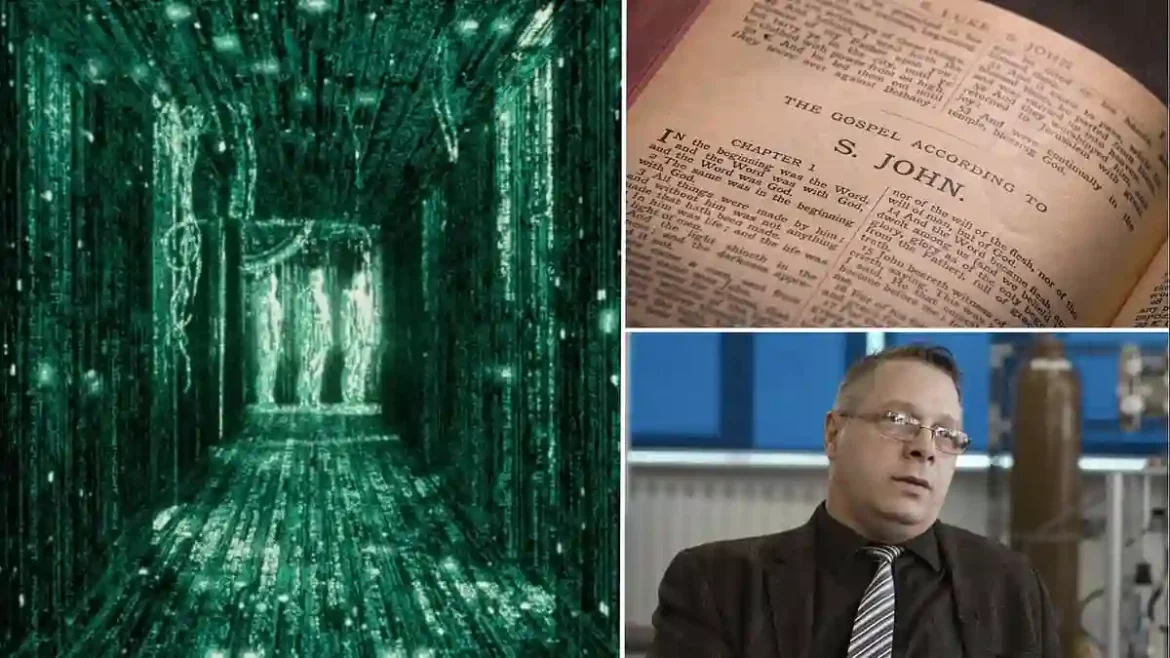Have you ever felt like your life resembles a scene from The Matrix?
According to a physicist, that feeling might not be far from reality.
Melvin Vopson, an associate professor at the University of Portsmouth, suggests that our entire universe could be an intricate computer simulation.
He even proposes that the evidence supporting this “simulation hypothesis” might be found within the pages of the Bible.
The Bible’s Hidden Messages
Vopson recently shared his intriguing ideas with MailOnline, stating, “The Bible itself tells us that we are in a simulation and it also tells us who is doing it.”
He claims that this simulation is orchestrated by an artificial intelligence (AI).
Specifically, he references the Gospel of John, which opens with the profound words: “In the beginning was the Word, and the Word was with God, and the Word was God.”
The professor believes that this line has significant theological importance but also offers fascinating implications regarding the nature of our universe.
He interprets “the Word” as representing the fundamental computer code that drives the simulation.
Much like in The Matrix, every simulation—large or small—consists of strings of code that dictate the rules of existence.
God Within the Simulation
Moreover, Vopson argues that the phrase “the Word was God” could imply that God exists within the simulation, not apart from it.
He posits that the divine being controlling everything—God—is embedded within the very code that runs the universe.
“The code running the simulation is not separate from the divine,” he explains, “but rather an integral part of it, perhaps an AI.”
The Gospel of John continues, stating, “All things were made by him, and without him was not anything made…”
This further supports Vopson’s theory, suggesting the existence of a Creator who formed the simulated universe through this divine code.
The act of creation, as described in the Bible, could be seen as a cosmic act of programming.
A New Perspective on Creation
Vopson’s theory may even provide clarity to a question many Christians ponder: how did God create the universe in six days?
If we take this theory seriously, it could mean that God crafted a simulated reality through a sophisticated computer program—a concept we now know is within the realm of possibility.
In summary:
- The Simulation Theory: The universe as a computer simulation.
- God’s Role: Potentially part of the simulation, possibly an AI.
- Biblical Connection: The Bible itself could be a part of this simulation, perhaps written by AI.
Reality Reloaded
In his latest book, Reality Reloaded: The Scientific Case for a Simulated Universe, Vopson discusses his hypothesis in greater detail.
Interestingly, he notes that he doesn’t necessarily believe in the theory but views it as an extraordinary observation that merits consideration.
He emphasizes that his ideas resonate with contemporary themes, especially the rise of AI, and mirror the concepts explored in The Matrix.
While some may find his claims controversial, Vopson asserts that they could have significant implications for Christian theology.
He believes that a belief in a simulated universe and the necessity of an omnipotent Creator can coexist harmoniously.
“This perspective aligns with religious beliefs that hold human life to be meaningful and purposeful, even within the context of a larger design,” he explains.
Clues in Our Reality
Vopson has also suggested that our lives contain numerous hints indicating we might be characters in a complex virtual world.
For instance, the limitations on the speed of light and sound could imply they are regulated by a computer’s processing speed.
He further claims that the laws of physics resemble computer code, while elementary particles might be likened to pixels in a digital image.
Additionally, he points out the symmetry found in nature—from flowers to butterflies and snowflakes—as a potential power-saving measure used by the machines to render this digitally constructed universe.
The Broader Conversation
Vopson’s ideas are not unique; many prominent figures, including Tesla founder Elon Musk and astrophysicist Neil deGrasse Tyson, have expressed similar views.
Musk stated at a conference in 2016 that the chances we’re living in a “base reality”—the actual universe—are “one in billions.”
This concept of “base reality” suggests layers of artificial realities, much like the plot of Inception.
Philosopher René Descartes famously noted in 1637, “Cogito, ergo sum,” which means “I think, therefore I am.”
This notion implies that the very ability to question our reality serves as evidence of our existence in some form.
What Lies Ahead?
So, as we ponder Vopson’s theory, we might wonder: What comes next in our understanding of reality?
Whether we view ourselves as participants in a grand simulation or as creations of a divine being, these questions challenge us to explore the depths of existence and our place within it.
Mine Crypto. Earn $GOATS while it is free! Click Here!!